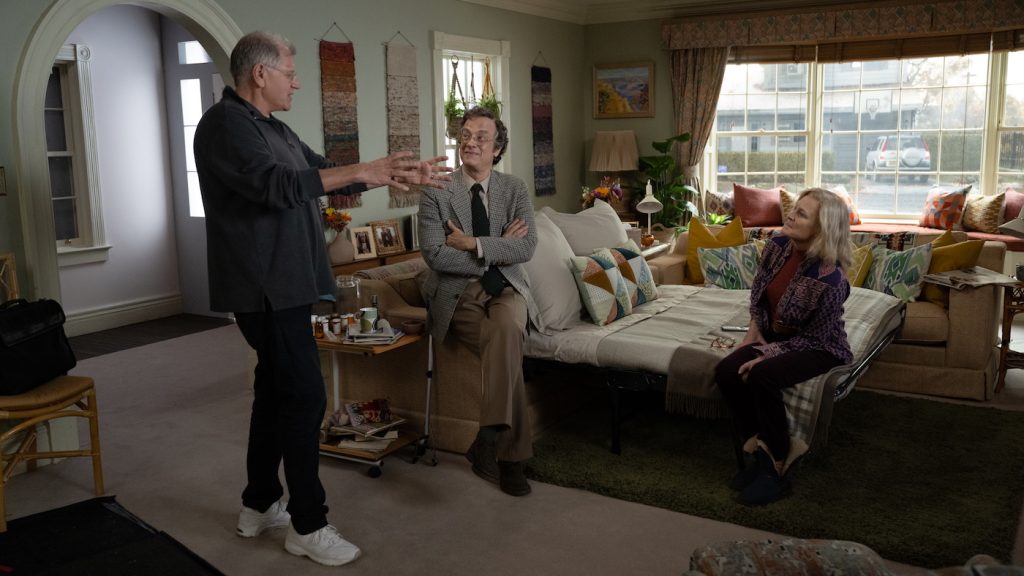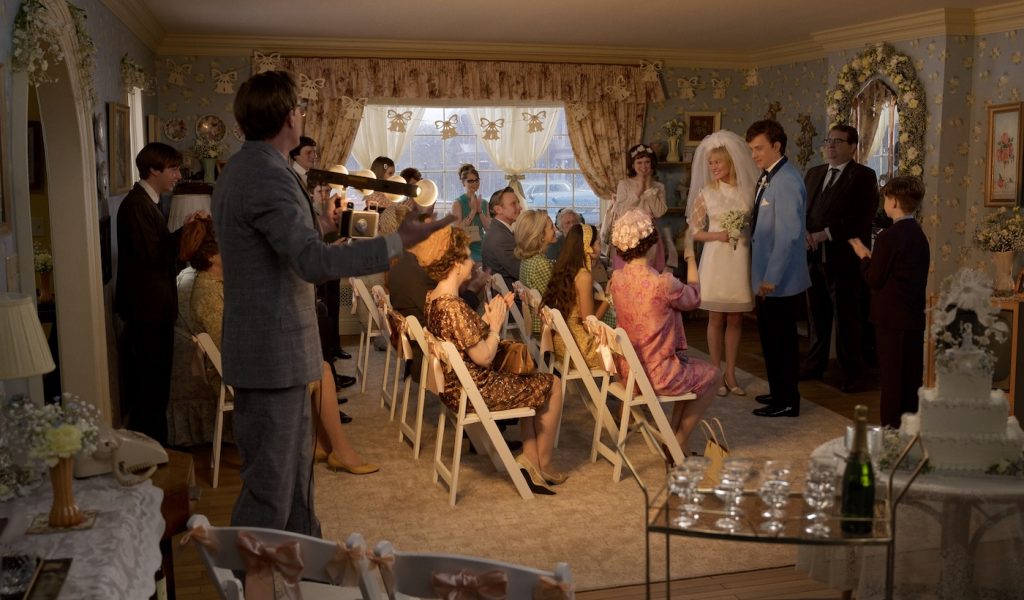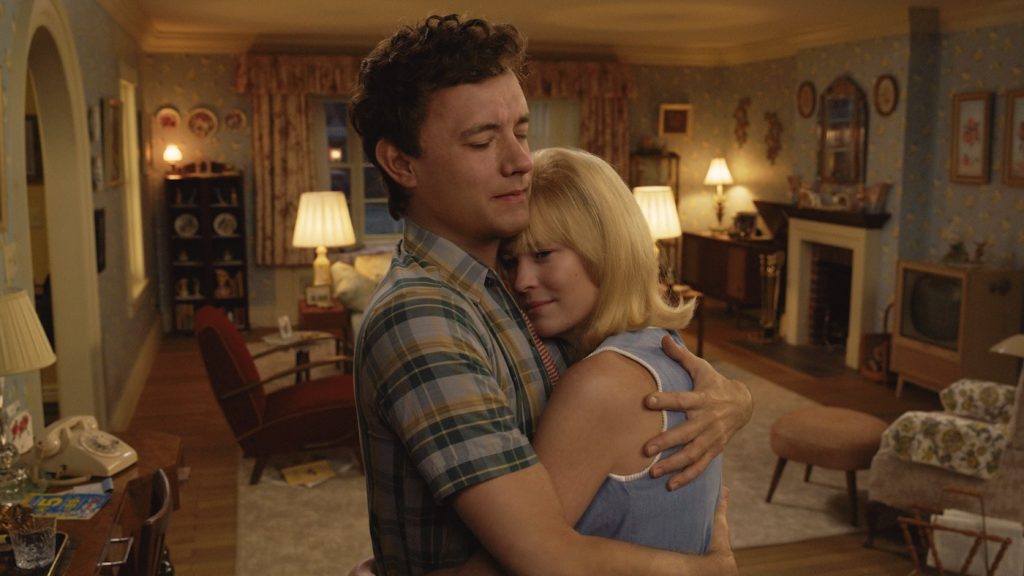“Forrest Gump” DP Don Burgess Re-Teams with Tom Hanks, Robin Wright, and Director Bob Zemeckis on “Here”
Cinematographer Don Burgess earned an Oscar nomination and helped make an American classic when she shot Forrest Gump in 1994. He’s since re-teamed with star Tom Hanks and director Bob Zemeckis on The Polar Express, Cast Away, and Disney’s live-action remake of Pinocchio. Now, he’s the man behind the camera in Here (in theaters) which pairs Hanks and his Gump co-star Robin Wright in a story that mainly unfolds across ten decades within one New Jersey living room.
True to its single-location theme, Here was filmed entirely at Pinewood Studios near London, where the cast, including Paul Bettany (WandaVision), Kelly Reilly (Yellowstone) and Michelle Dockery (Downton Abbey) gathered under Zemeckis’ watchful eye. Making a Zemeckis movie is “not easy,” Burgess laughs. “Our running gag is Bob saying, ‘Anybody could do it that way, but how about we try something else?'” Here also offered Burgess the perk of getting to hang out with Hanks. Burgess says. “Tom’s a lovely man to be around and very dedicated to the craft of making movies.”
Speaking from Los Angeles, Burgess talks about his unmovable camera and how the Here team deployed AI technologies as a de-aging fountain of digital youth.
Here represents another adventure in experimental cinema from Bob Zemeckis. When you guys first talked about the project, what was your creative brief?
The goal was to do as much in-camera as we could by combining all the different technologies to record the image in-camera so that what we see in the final movie is captured in that first recording.
The picture window in the living room conveys what’s going on outdoors from 1907, when the house was built, to the present day in 2022. How did you prep the lighting for that scenery?
We used LED Wall technology as the backing for our window. The script supervisor and I came up with the exact day and time for every scene in the movie, so I had the room lighting pre-programmed in the computer 24/7, 365 days a year. We might say “It’s summer, we’re in New Jersey at 8:30 at night so it’s still light out.” We had our go-to settings for overcast, rain, snow, and wind, as well as the seasons, but the lighting was never done until we were ready to shoot, in case Bob wanted to call an audible and change something. Then we’d dial it in, block the scene and shoot.

That sounds like a lot of pre-planning.
The issue is that you have to build the entire asset before you start shooting, and then you need to be in command of the entire image from minimum focus to infinity on any given shot. Rather than pushing those decisions off into post-production, it all has to be front-loaded before you start shooting.
Once you did start shooting, how did you approach camera placement?
For Bob, it was important that the camera be invisible. He didn’t want the audience to notice camera movement, and he didn’t want you to pull focus. What he was really talking about was depth of field. We didn’t want the camera to exaggerate anything. You keep coming back to the same location, but it’s a completely different scene, from dinosaurs to indigenous people to the building of the house. Everything keeps evolving at exactly the same spot on the planet.
How did you arrive at your ideal depth of field?
Once I grasped what Bob was trying to get at, I figured out how to limit my exposure to a certain ASA [light-sensitive film speed] with a certain f-stop on the lens to create the right depth of field. And then there’s the LED wall to consider: What does that need to be exposed at? To come up with the best-looking image, I tested different lenses different cameras, and put all that stuff in a bowl, and stirred it around to come up with hopefully the best package to shoot the film.

Which was…?
We ended up using a Panavision P70 35-millimeter lens set to a 5.6 f-stop. That became our sweet spot.
And camera?
The RED Raptor, with a digital 8 K resolution chip. In combination with the P70, which is a large format lens, we pushed the ASA to [the maximum] 1600, and that allowed me to expose the LED wall.
It’s interesting that your camera remains stationary throughout the film. Did you just put it on a tripod and leave it there?
Bob didn’t want anything underneath the camera or on either side of it. He didn’t want a dolly, a tripod, or the camera to move at all, so we bolted it to the floor with some box steel bracing and hung it from above. Mounting the rig and building the set around it became quite a challenge, making sure we could get the camera back to that exact same spot every single day.

You have now shot five Zemeckis movies starring starring Tom Hanks. What’s it like to observe one of America’s finest actors at close hand?
It’s a pleasure sitting in the front row and watching what Tom does because he really brings it for every take. He’s not fooling around out there. He’s done his homework, he knows what his character’s about, but he is also willing [to take direction]. Many times, I’ve seen the director say, for example, “Tom, I need you to go to the window” because the audience has got to see out this window, and Tom will say, “Watch this.” He’ll take it as a challenge! And he’s smart about it. He’ll convince us that he needs to go to that window.
And, of course, Hanks shares a special rapport with Zemeckis.
They’re both so good at what they do. Tom and Bob make it look easy. It’s not easy.
Bob Zemeckis is known for pioneering new filmmaking tools. In The Polar Express, he became one of the first directors to use motion capture technology. In recent years, Artificial Intelligence has played an increasingly important role in the culture. How did AI impact your work on Here?
The big AI challenge for this movie was de-aging the actors so they could play their characters at the age they needed to be. AI technology enabled us to take the [actor’s] live image and basically show us, a little glitchy, what they looked like when they were young. We had two monitors right next to each other so you could see what Tom and Robin really look like today and what they’re going to look like when the movie’s done.
Wow. Instead of applying makeup or prosthetics, you’re essentially placing an AI-sourced young face on the actor.
Yeah, and it’s kind of mind-blowing when you first see this happen on the spot. I think it stimulated the actors to see themselves at that age, and for some of us who knew Tom and Robin when they were [30 years] younger, it was, “Oh my God!”
For more upcoming films from Sony Pictures, check out these stories:
“Venom: The Last Dance” Stunt Coordinator James Churchman on Tom Hardy, Wild Horses and Flying Kids
Ralph Fiennes Says That Danny Boyle’s “28 Years Later” Was Shot Partly On an iPhone
Featured image: Tom Hanks and Robin Wright star in HERE. Courtesy Sony Pictures.



